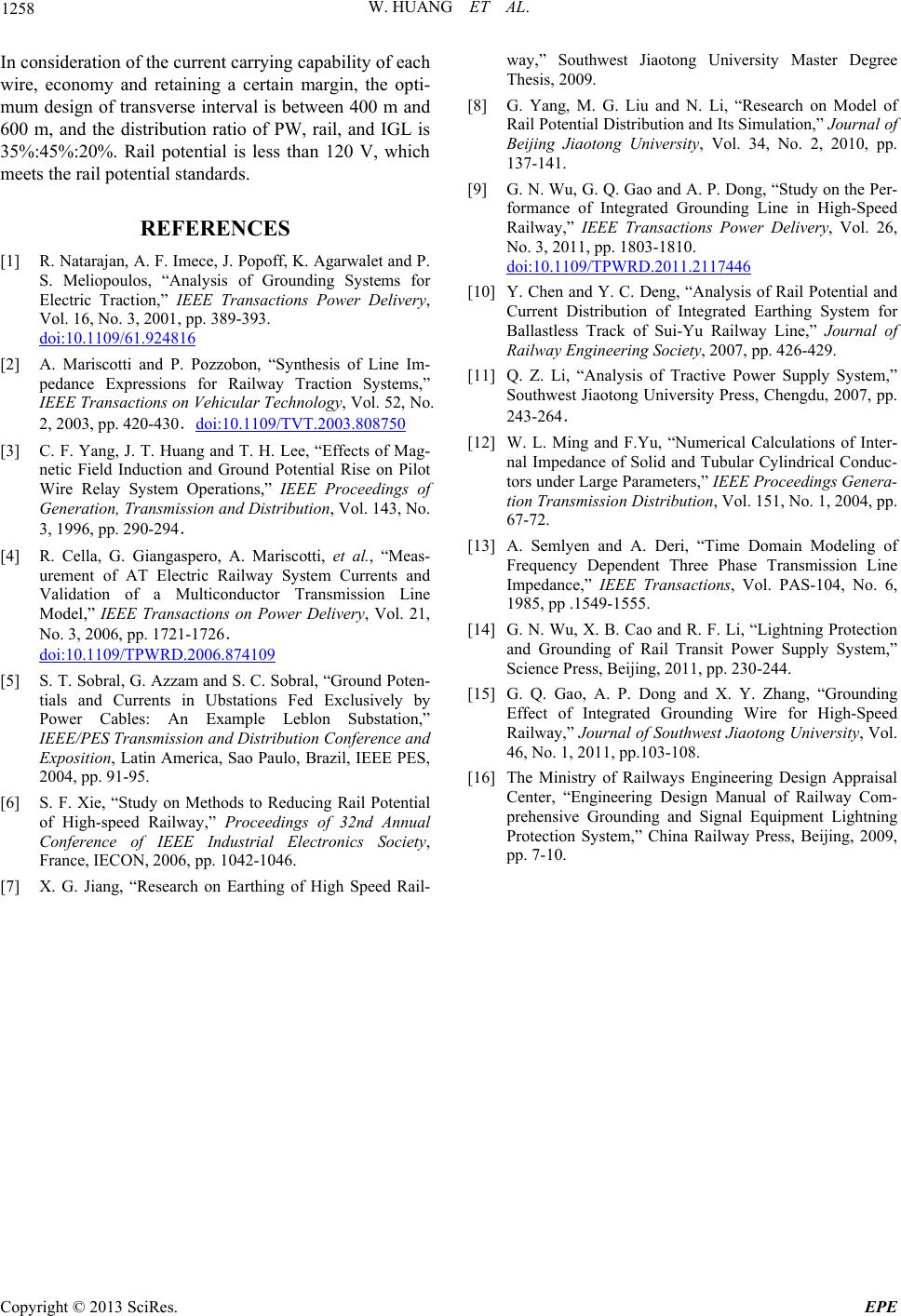
W. HUANG ET AL.
Copyright © 2013 SciRes. EPE
1258
In consideration of the current carrying cap ability of each
wire, economy and retaining a certain margin, the opti-
mum design of transverse interval is between 400 m and
600 m, and the distribution ratio of PW, rail, and IGL is
35%:45%:20%. Rail potential is less than 120 V, which
meets the rail potential standards.
REFERENCES
[1] R. Natarajan, A. F. Imece, J. Popoff, K. Agarwalet and P.
S. Meliopoulos, “Analysis of Grounding Systems for
Electric Traction,” IEEE Transactions Power Delivery,
Vol. 16, No. 3, 2001, pp. 389-393.
doi:10.1109/61.924816
[2] A. Mariscotti and P. Pozzobon, “Synthesis of Line Im-
pedance Expressions for Railway Traction Systems,”
IEEE Transactions on Vehicular Technology, Vol. 52, No.
2, 2003, pp. 420-430.doi:10.1109/TVT.2003.808750
[3] C. F. Yang, J. T. Huang and T. H. Lee, “Effects of Mag-
netic Field Induction and Ground Potential Rise on Pilot
Wire Relay System Operations,” IEEE Proceedings of
Generation, Transmission and Distribution, Vol. 143, No.
3, 1996, pp. 290-294.
[4] R. Cella, G. Giangaspero, A. Mariscotti, et al., “Meas-
urement of AT Electric Railway System Currents and
Validation of a Multiconductor Transmission Line
Model,” IEEE Transactions on Power Delivery, Vol. 21,
No. 3, 2006, pp. 1721-1726.
doi:10.1109/TPWRD.2006.874109
[5] S. T. Sobral, G. Azzam and S. C. Sobral, “Ground Poten-
tials and Currents in Ubstations Fed Exclusively by
Power Cables: An Example Leblon Substation,”
IEEE/PES Transmission and Distribution Conference and
Exposition, Latin America, Sao Paulo, Brazil, IEEE PE S,
2004, pp. 91-95.
[6] S. F. Xie, “Study on Methods to Reducing Rail Potential
of High-speed Railway,” Proceedings of 32nd Annual
Conference of IEEE Industrial Electronics Society,
France, IECON, 2006, pp. 1042-1046.
[7] X. G. Jiang, “Research on Earthing of High Speed Rail-
way,” Southwest Jiaotong University Master Degree
Thesis, 2009.
[8] G. Yang, M. G. Liu and N. Li, “Research on Model of
Rail Potential Distribution and Its Simulation,” Journal of
Beijing Jiaotong University, Vol. 34, No. 2, 2010, pp.
137-141.
[9] G. N. Wu, G. Q. Gao and A. P. Dong, “Study on the Per-
formance of Integrated Grounding Line in High-Speed
Railway,” IEEE Transactions Power Delivery, Vol. 26,
No. 3, 2011, pp. 1803-1810.
doi:10.1109/TPWRD.2011.2117446
[10] Y. Chen and Y. C. Deng, “Analysis of Rail Potential and
Current Distribution of Integrated Earthing System for
Ballastless Track of Sui-Yu Railway Line,” Journal of
Railway Engineering Society, 2007, pp. 426-429.
[11] Q. Z. Li, “Analysis of Tractive Power Supply System,”
Southwest Jiaotong University Press, Chengdu, 2007, pp.
243-264.
[12] W. L. Ming and F.Yu, “Numerical Calculations of Inter-
nal Impedance of Solid and Tubular Cylindrical Conduc-
tors under Large Parameters,” IEEE Proceedings Genera-
tion Transmission Distribution, Vol. 151, No. 1, 2004, pp.
67-72.
[13] A. Semlyen and A. Deri, “Time Domain Modeling of
Frequency Dependent Three Phase Transmission Line
Impedance,” IEEE Transactions, Vol. PAS-104, No. 6,
1985, pp .1549-1555.
[14] G. N. Wu, X. B. Cao and R. F. Li, “Lightning Protection
and Grounding of Rail Transit Power Supply System,”
Science Press, Beijing, 2011, pp. 230-244.
[15] G. Q. Gao, A. P. Dong and X. Y. Zhang, “Grounding
Effect of Integrated Grounding Wire for High-Speed
Railway,” Journal of Southwest Jiaotong University, Vol.
46, No. 1, 2011, pp.103-108.
[16] The Ministry of Railways Engineering Design Appraisal
Center, “Engineering Design Manual of Railway Com-
prehensive Grounding and Signal Equipment Lightning
Protection System,” China Railway Press, Beijing, 2009,
pp. 7-10.